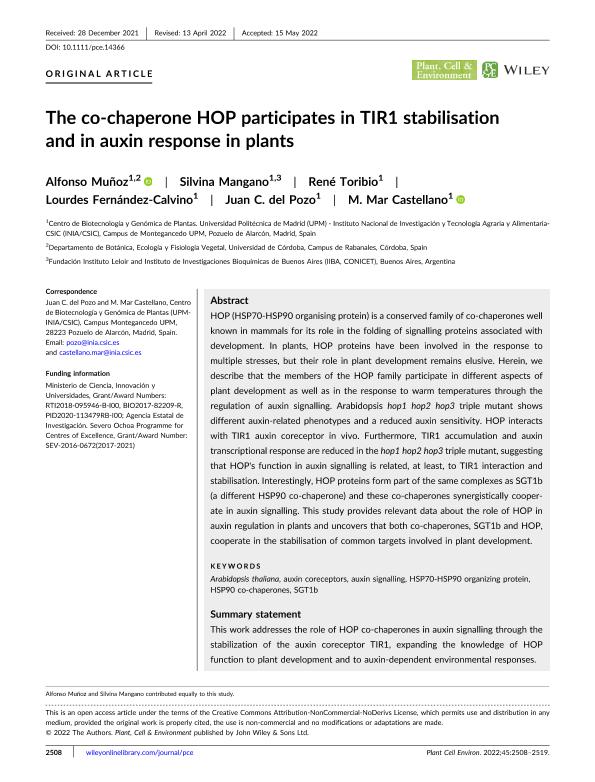Artículo
The co-chaperone HOP participates in TIR1 stabilisation and in auxin response in plants
Muñoz, Alfonso; Mangano, Silvina ; Toribio, René; Fernández Calvino, Lourdes; del Pozo, Juan C.; Castellano, M. Mar
; Toribio, René; Fernández Calvino, Lourdes; del Pozo, Juan C.; Castellano, M. Mar
 ; Toribio, René; Fernández Calvino, Lourdes; del Pozo, Juan C.; Castellano, M. Mar
; Toribio, René; Fernández Calvino, Lourdes; del Pozo, Juan C.; Castellano, M. Mar
Fecha de publicación:
08/2022
Editorial:
Wiley Blackwell Publishing, Inc
Revista:
Plant, Cell and Environment
ISSN:
0140-7791
Idioma:
Inglés
Tipo de recurso:
Artículo publicado
Clasificación temática:
Resumen
HOP (HSP70-HSP90 organising protein) is a conserved family of co-chaperones well known in mammals for its role in the folding of signalling proteins associated with development. In plants, HOP proteins have been involved in the response to multiple stresses, but their role in plant development remains elusive. Herein, we describe that the members of the HOP family participate in different aspects of plant development as well as in the response to warm temperatures through the regulation of auxin signalling. Arabidopsis hop1 hop2 hop3 triple mutant shows different auxin-related phenotypes and a reduced auxin sensitivity. HOP interacts with TIR1 auxin coreceptor in vivo. Furthermore, TIR1 accumulation and auxin transcriptional response are reduced in the hop1 hop2 hop3 triple mutant, suggesting that HOP's function in auxin signalling is related, at least, to TIR1 interaction and stabilisation. Interestingly, HOP proteins form part of the same complexes as SGT1b (a different HSP90 co-chaperone) and these co-chaperones synergistically cooperate in auxin signalling. This study provides relevant data about the role of HOP in auxin regulation in plants and uncovers that both co-chaperones, SGT1b and HOP, cooperate in the stabilisation of common targets involved in plant development.
Archivos asociados
Licencia
Identificadores
Colecciones
Articulos(IIBBA)
Articulos de INST.DE INVEST.BIOQUIMICAS DE BS.AS(I)
Articulos de INST.DE INVEST.BIOQUIMICAS DE BS.AS(I)
Citación
Muñoz, Alfonso; Mangano, Silvina; Toribio, René; Fernández Calvino, Lourdes; del Pozo, Juan C.; et al.; The co-chaperone HOP participates in TIR1 stabilisation and in auxin response in plants; Wiley Blackwell Publishing, Inc; Plant, Cell and Environment; 45; 8; 8-2022; 2508-2519
Compartir
Altmétricas



